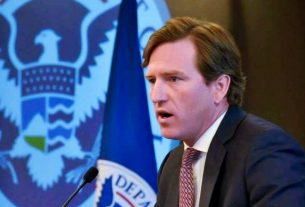![]() Albuquerque Indian School in 1885, relocated from Duranes in 1881 (Photo from the National Archive)
Albuquerque Indian School in 1885, relocated from Duranes in 1881 (Photo from the National Archive)
Thu 12 May 2022:
Boarding schools were part of a policy to sever cultural traditions and take land from Indigenous people, government report finds
Los Angeles, California – A US government investigation has found at least 53 separate burial sites at federal Native American boarding schools, and officials expect to find more, according to a new report released Wednesday.
The initial findings of the investigation, which examined records under federal control, show that hundreds of children died in boarding school, but officials say the number is likely to climb into the thousands or tens of thousands as the investigation continues.
The 106-page report is the first volume of the continuing Federal Indian Boarding Schools Initiative, ordered by Interior Secretary Deb Haaland in June 2021 after she heard the news that Tk’emlups te Secwepemc First Nation had confirmed 215 children’s graves at the Kamloops Indian Residential School in British Columbia.
The United States intentionally forced Indigenous families to send their children to school as part of an assimilation system that reached every corner of the country, according to the report. It found the boarding school system was “expansive”, consisting of 408 “federal Indian boarding schools” across 37 states and territories, including 21 schools in Alaska and seven schools in Hawaii.
The creation of this system was part of a broader policy to take land from Indigenous people to allow for the expansion of the US, the report found. In it, the government acknowledges its assimilation policy caused loss of life, physical and mental health, territories and wealth, tribal and family relations, and Indigenous languages, as well as the erosion of religious and cultural practices.
“When my maternal grandparents were only eight years old, they were stolen from their parents’ culture and communities, and forced to live in boarding schools until the age of 13,” Haaland told reporters Wednesday. “Many children like them never made it back to their homes.”
She said Indigenous staff worked through their own trauma and pain to complete the report. “This is not new to us,” she said, gesturing toward other Indigenous people who attended and spoke at the press conference.
What the report found
The policy dates back to 1819, when Congress passed the Civilization Fund Act to financially support religious organisations that ran schools to assimilate Indigenous children.
After that, the federal government “induced or compelled” generations of American Indian, Alaska Native and Native Hawaiian children to attend boarding schools. Beginning in 1871, Congress passed laws ordering parents to send their children to school, and authorised the Interior Secretary to withhold rations to those who refused.
 The Carlisle Indian Industrial School in Pennsylvania around 1890. (Photo from the Library of Congress)
The Carlisle Indian Industrial School in Pennsylvania around 1890. (Photo from the Library of Congress)
Families hid their children, and officials sent police to seize them, the report said. More than 150 treaties, which were often signed under duress, included requirements that communities send their children to school.
From its earliest days, the US’s official objective was to sever cultural and economic ties of Indigenous people to their land. “The assimilation of Indian children through the Federal Indian boarding school system was intentional and part of that broader goal of Indian territorial dispossession for the expansion of the United States,” the report confirmed.
The US used a twin policy of land dispossession and school systems to separate Indigenous people from their land and culture. This was the cheapest and safest way to take Indigenous land for the benefit of white people, the report states, citing the 1969 Kennedy Report.
The policy extended beyond boarding schools to include at least 1,000 other federal and non-federal institutions, including American Indian day schools, sanitariums, asylums, orphanages, and stand-alone dormitories that also aimed to educate Indigenous people.
Boarding schools were supported by both federal money and funds obtained from tribal trust accounts maintained by the US for the benefit of Indigenous people, the report said.
The intentional removal of Indigenous children from their communities “was both traumatic and violent”, the investigation found. They were sent to institutions that were run in a “rigid military fashion with heavy emphasis on rustic vocational education”.
The schools deployed “systematic militarised and identity-alteration methodologies”, including renaming children from Indigenous to English names, cutting their hair short, requiring uniforms, discouraging or preventing religious and cultural practices, and organising children into units to perform military drills. The institutions also forced children to perform manual labour, including sewing garments and agricultural production, the report found.
If children spoke their language or practised their culture, they faced severe punishment, including solitary confinement, humiliation, flogging, withholding food, whipping, slapping and cuffing. Older children were forced to punish younger children. When they ran away and were caught, they faced physical punishment including whipping.
How did children die?
While the report doesn’t detail exactly how children died, it does describe conditions that could lead to death. “Rampant physical, sexual and emotional abuse; disease; malnourishment; overcrowding; and lack of health care in Indian boarding schools are well-documented.”
According to the report, young, malnourished children were forced to perform industrial labour. The report states that federal reporting of child deaths, including the number and cause of death, is inconsistent.
In Southern California, the federal government ran an off-reservation boarding school called the Sherman Institute. Its cemetery holds more than 60 graves, most of them students.
Jean Keller, a historian who wrote a book about the Sherman Institute, told Al Jazeera that most of the children died from diseases including typhoid fever, tuberculosis and influenza. Others died in accidents — one was killed when he was hit in the head with a hammer that children were throwing on the playing field, and another child was killed when a bakery oven exploded.
Marsha Small, a northern Cheyenne researcher, surveyed the Chemawa Indian School cemetery in Oregon using various tools and found 210 graves associated with the boarding school — most of them children. She said many died from cholera, influenza and tuberculosis.
“They’re going to find that there are more bodies than there are records,” Small told Al Jazeera. She believes that because the government and churches had no respect for Indigenous children, so they likely did not properly account for every death. “It was genocide,” she said.
According to the report, tribes have widely varied preferences for the possible repatriation of remains, presenting a problem for the federal initiative. Some burial sites contain remains of multiple people, or remains that were relocated from other sites, meaning it may be impossible to identify them, the report said.
Small told Al Jazeera that children from different nations are buried next to each other at Chemawa, and each tribe has different protocols — some may want to exhume the remains and bring them home to be buried on their traditional lands, while others may not want the graves touched at all.
What happens next?
“Our children deserve to be found, our children deserve to be brought home,” Deborah Parker, CEO of the National Native American Boarding School Healing Coalition (NABS), told reporters on Wednesday. “We are here for their justice, and we will not stop advocating until the United States fully accounts for the genocide committed against Native children.”
Parker told Al Jazeera that NABS worked closely with the department on the new report, but she is also calling for a wider investigation into boarding schools.
She is pushing for Senate Bill 2907 and House Bill 5444 that would establish a Congressional truth and healing commission to conduct a full inquiry. While the federal initiative will examine its own records, she said the commission would also pull records across federal, state, hospital and church archives and private collections, widening the scope. It would also collect testimony from survivors and experts.
She called on Pope Francis to open the Catholic Church’s records and to apologise to Native American boarding school survivors, as he has done for survivors in Canada. She added that President Joe Biden should apologise to boarding school survivors on behalf of the US government. She believes survivors are owed reparations. “Some of us have given up hope, which is why you see suicides, alcoholism, abuse, self-abuse, because we have been forgotten for so long,” she told Al Jazeera.
June 1900, Phoenix. (U.S. National Archives and Records Administration)
The government has never given survivors a chance to share their stories, and the report recommends that it develop a platform for survivors to formally document their experiences.
Haaland announced Wednesday that the initiative will travel across the country in a year-long “Road to Healing” to allow survivors to contribute their stories to a permanent oral history collection. The tour will provide trauma-informed support, the department said.
The report also recommends that the department should approximate the amount of tribal trust funds used to support the boarding school system, and identify groups that received the funds. It also recommends examining the connection between boarding schools and the foster care system.
The department says it will produce a second report with the locations of marked or unmarked burial sites, and the names, ages and tribal affiliations of the children buried there.
Haaland said she considers it her responsibility and legacy to uncover the dark history of the institutions. “The fact that I am standing here today as the first Indigenous cabinet secretary is testament to the strength and determination of Native people,” she said.
“I am here because my ancestors persevered,” she said, her voice shaking. “I stand on the shoulders of my grandmother and my mother, and the work we will do with the federal Indian boarding schools initiative will have a transformational impact on the generations who follow.”
___________________________________________________________________________________________________________________________________________
FOLLOW INDEPENDENT PRESS:
TWITTER (CLICK HERE)
https://twitter.com/IpIndependent
FACEBOOK (CLICK HERE)
https://web.facebook.com/ipindependent
Think your friends would be interested? Share this story!






